
What Is On-Page SEO?
On-page SEO is like preparing your ranch for visitors—it’s about making every corner of your website shine. It focuses on optimizing the content and structure of your web pages so they work better for search engines and your audience. When done right, it helps your site rank higher on Google and brings more people to your online business.
Here’s what on-page SEO covers:
- Aligning your content with what your audience is searching for (search intent).
- Polishing title tags, internal links, and URLs.
- Ensuring your website is easy to navigate and visually appealing.
If you’re just starting with SEO, this is where you should put your energy. On-page SEO gives you the reins to control how your site performs and connects with your audience.
On-Page SEO vs. Off-Page SEO
Think of SEO as a two-part strategy:
On-Page SEO
This is what you can control directly on your website. It includes optimizing content quality, adding meta tags, improving mobile-friendliness, and structuring internal links. Think of it as caring for the inside of your ranch—making it inviting and functional.
Off-Page SEO
This happens outside your website. It focuses on building authority and trust through backlinks, social media engagement, and brand mentions. It’s like networking at a rodeo—your reputation grows the more people talk about you.
Both are important, but on-page SEO gives cowgirl entrepreneurs the reins to take control.
It’s the smartest place to start if you want a strong foundation for your website. With simple, actionable, on-page SEO tips, you can make a real impact.
When you focus on on-page SEO, your cowgirl brand can shine brighter online. You’ll bring in more traffic, connect with your dream customers, and keep them coming back for more.
Let’s saddle up and take that first step!

Why Is On-Page SEO Important?
On-page SEO is like preparing your website for success—it helps search engines understand whether your page matches what people are looking for. Keywords, structure, and other elements signal to search engines that your content is relevant and useful.
When your page aligns with a user’s search intent, Google is more likely to showcase it at the top of search results. That means more eyes on your cowgirl brand and more potential customers visiting your site.
Here’s the thing: Google’s algorithm is always changing, but one priority stays the same—user experience. Google values “people-first content,” which means creating content that’s valuable, helpful, and meets your audience’s needs.
For cowgirl entrepreneurs, this means making your content as authentic and engaging as the products you sell.
9 On-Page SEO Techniques for Your Website
To get your site ready to rank higher and draw more visitors, here are nine essential on-page SEO techniques:
- Write unique, helpful content.
- Place target keywords strategically.
- Write keyword-rich title tags.
- Write click-worthy meta descriptions.
- Use headings and subheadings to structure your page.
- Optimize URLs.
- Add internal links.
- Add external links.
- Include and optimize images.
Let’s break these down further.
1. Write Unique, Helpful Content
Creating high-quality content is like crafting the perfect cowgirl hat—it needs to fit your audience’s needs and stand out. One of the most critical on-page SEO steps is ensuring your content matches what readers are searching for.
Start by researching keywords to guide your content. Use tools like the Keyword Magic Tool to find ideas. For example, if you search “cowgirl outfit,” the tool will provide a list of related keywords sorted by search volume.
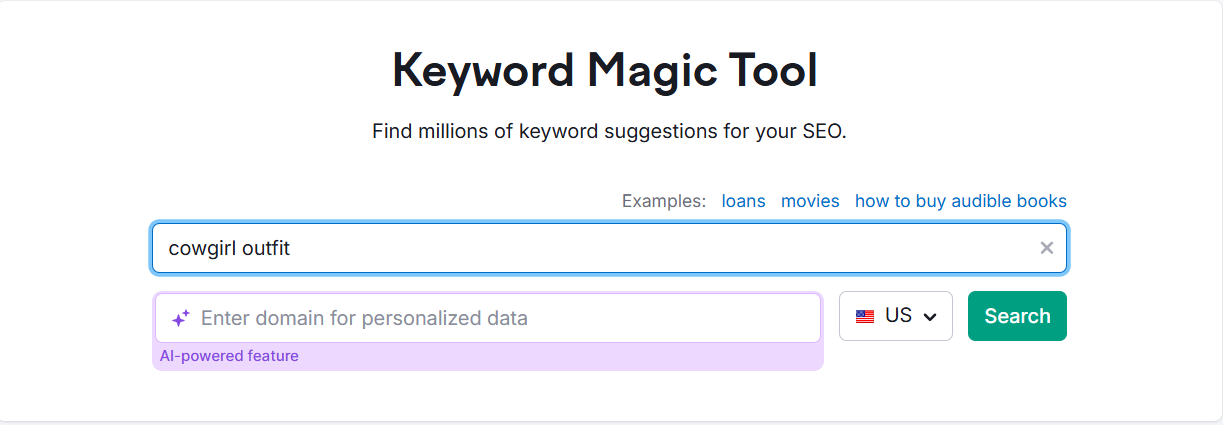
Keep an eye on the keyword difficulty (KD %) score. High KD keywords are tougher to rank for, like trying to wrangle a wild stallion.
Start with low KD keywords—those under 29%. They’re easier to tackle and give your cowgirl brand a better chance to rank quickly.
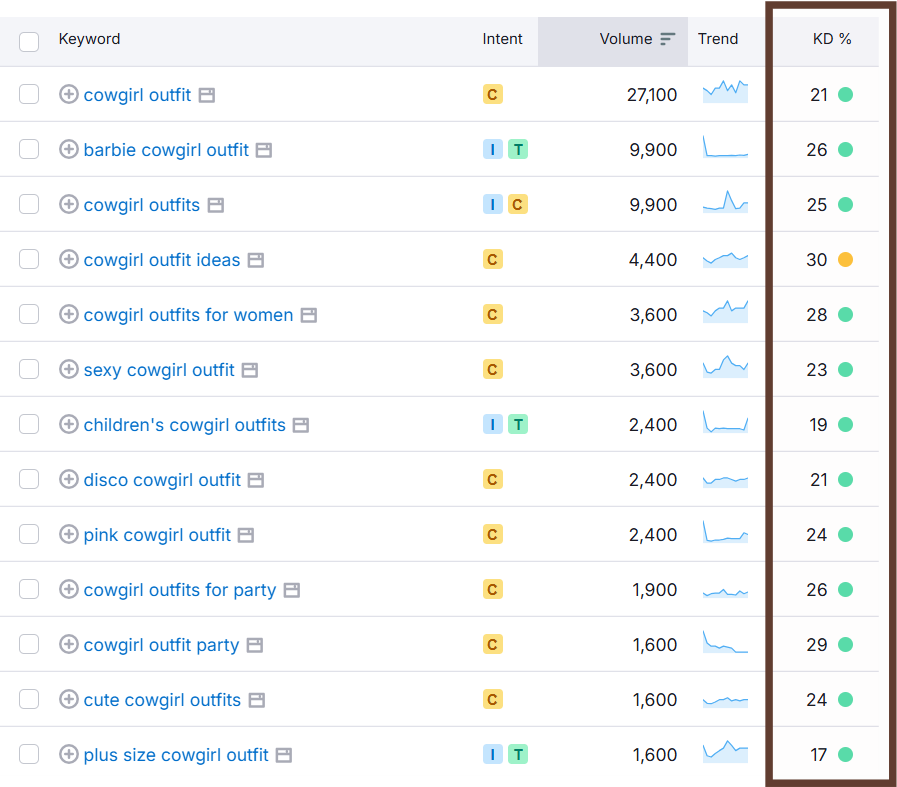
It’s like finding the easiest trail to get your audience to notice you first.

Focus on keywords with high search volume, but don’t overlook long-tail keywords.
These are longer, more specific phrases that may have lower competition, making them easier to rank for. Think of them as the hidden trails that lead to less crowded, valuable opportunities.
Once you’ve chosen your keywords, you’re ready to create your content. Here are some best practices to guide you:
- Naturally incorporate keywords into your text. Don’t force them in—let them flow like a good conversation.
- Match your content to the intent behind the keyword. Answer questions, solve problems, or inspire your readers.
- Fully address the query so your content is truly helpful. Give readers everything they’re looking for and more.
- Offer something unique. Think about what makes your content stand out compared to competitors.
- Use visuals to enhance your content. Images, videos, or infographics can make your page more engaging.
Focus on these steps to create content that’s optimized and valuable for your audience. It’s all about giving your readers something they can’t find anywhere else—just like a one-of-a-kind cowgirl accessory.
Key Areas to Place Keywords
- H1 (Main Heading): Your page’s primary heading should include your target keyword. It sets the tone for the content.
- First Paragraph: Keywords here grab both Google’s and your readers’ attention right away.
- Subheadings (H2s, H3s): Use keywords in subheadings to guide readers and reinforce your content’s focus.
This strategy signals to Google that your page is relevant while helping users quickly determine if your content matches their needs.
Pro Tip:
Don’t overuse your keywords. They should feel natural within the flow of your content. Keyword stuffing can harm your rankings and turn off your audience.
3. Write Keyword-Rich Title Tags
Title tags are like the signs outside your ranch gate—they tell visitors (and search engines) what to expect before stepping inside. These short snippets of text show up on search engine results pages (SERPs), social media posts, and browser tabs, playing a big role in whether someone clicks on your page.

Here’s how to write title tags that stand out:
- Keep It Brief: Aim for 50 to 60 characters. This keeps your title readable and prevents Google from cutting it off.
- Use Your Target Keyword: This helps Google understand your page and reassures readers they’ve found what they’re looking for.
- Be Unique: Every page should have its own title. Avoid duplicates so Google knows exactly what each page is about, and users can confidently click through.
For example, instead of writing something generic like “Western Hats,” try “10 Stylish Cowgirl Hats for Every Occasion.”
With the right title tags, you’re not just showing up on the search results—you’re making an unforgettable first impression. Make every word count, cowgirl!
4. Write Click-Worthy Meta Descriptions
Meta descriptions are like the quick pitch for your cowgirl brand. They’re the short summaries that show up under your page title on Google’s search results. While they don’t directly affect rankings, they can make or break whether someone clicks your link or skips to the next.
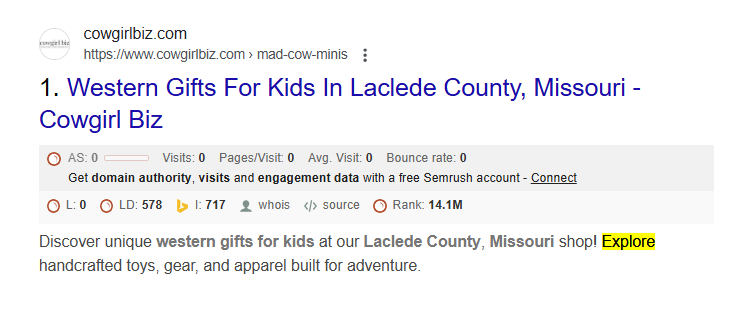
Here’s how to write meta descriptions that grab attention:
- Keep It Short: Aim for under 120 characters so it displays fully on mobile devices.
- Include Your Target Keyword: This helps users see that your page matches their search and makes your description stand out, as Google often bolds matching terms.
- Use Active Voice: Be direct and clear to get your message across in fewer words.
- Add a Call to Action (CTA): Invite users to take action with phrases like “Explore now” or “Learn more.”
If your meta description doesn’t match the search intent or page content, Google might create its own version. To avoid this, ensure your meta description aligns perfectly with what your page delivers.
A strong meta description is like a catchy rodeo announcement—it draws people in and gets them excited about what’s coming next. Make every word count, cowgirl!
5. Use Headings and Subheadings to Structure Your Page
Headings are like signposts on a long trail—they guide your readers and search engines through your content. Without them, your page can feel like an open pasture with no clear path. But with properly organized headings, readers can easily skim your page and find what they need, and Google can better understand your content’s structure.
Headings, especially H1 tags, are essential for organizing your page and giving Google the context it needs to match your content with user searches. A clear structure also helps you rank higher for relevant keywords.

Here’s how to make the most of your headings:
- Use H1 for your page’s title or main headline. This is the first thing your readers and Google will notice.
- Add H2 tags to break your content into clear subtopics. These act as chapter titles for your page.
If needed, use H3s and H4s to dive deeper into specific sections.
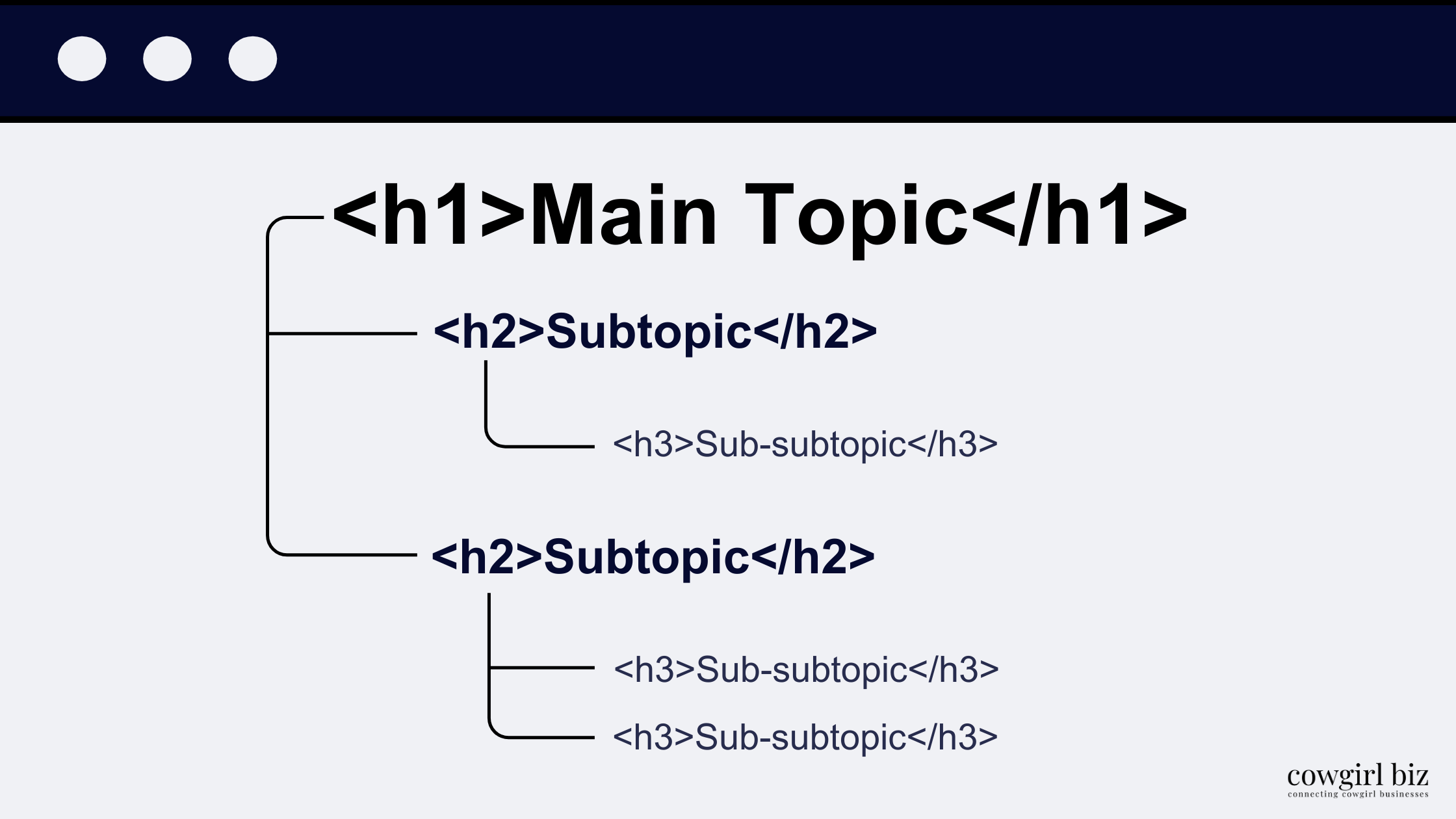
Incorporate keywords naturally into your headings. This helps Google connect your content to user queries while keeping it relevant for readers.
Proper headings are more than just formatting—they’re tools to make your page engaging and accessible. When done right, they help your audience navigate your site easily and keep Google pointing searchers in your direction.
Keep your page structured, clear, and ready to impress!
6. Optimize URLs
Think of your URLs as trail markers on your website. They should be clear, simple, and guide both search engines and readers to the right destination. Google prefers URLs that are clean and easy to understand—not ones that look confusing or cluttered.
Here’s How to Optimize Your URLs:
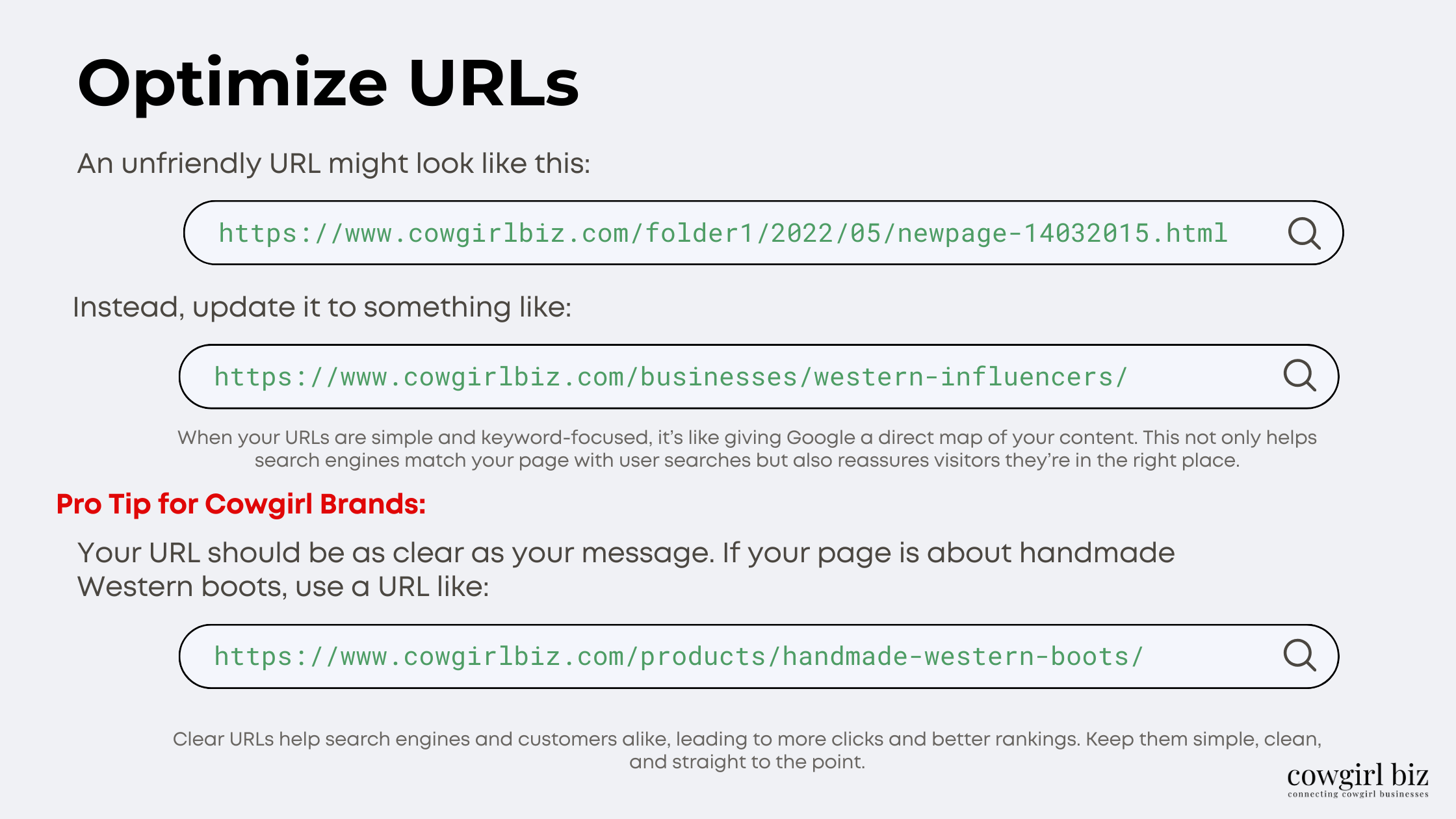
- Keep It Relevant: Use words that reflect your content so users instantly know what your page is about.
- Avoid Random Add-Ons: Skip using numbers, dates, or unnecessary symbols in your URLs. Most website themes create these by default, so always update before publishing.
- Include Your Target Keyword: Incorporate a keyword that matches your page topic. This helps Google connect your content to relevant search queries.
7. Strategically Add Internal Links
Internal links are like the trusty paths connecting different parts of your ranch. They guide visitors (and search engines) through your website, showing them the relationship between your pages.
Here’s why internal links are a must for on-page SEO:
- Help Google Understand Your Site: They give search engines a map of your website’s structure, showing how your pages connect.
- Aid in Crawling New Pages: Google crawlers use these links to discover and index new content faster.
- Boost Page Value: Linking to a page signals its importance, making Google more likely to rank it higher.
- Improve User Navigation: Links guide visitors to explore more content, keeping them engaged and on your site longer.
For example, if you’ve written a blog about “Handmade Cowgirl Boots,” link it to your product page featuring those boots. It’s like pointing your audience to the next stop on the trail.
Internal links not only enhance your website’s usability but also strengthen your SEO strategy. Keep them relevant, helpful, and easy to follow—just like a well-marked path.
8. Add External Links to Authoritative Sources
External links are like sending your readers to a trusted partner. They enhance trust, improve user experience, and show Google you value accuracy.
Link only to reputable sources that align with your topic. Use natural, descriptive anchor text so readers know where they’re headed. Keep links relevant and balanced to avoid looking spammy.
Strong, purposeful links not only help your audience but also boost your site’s credibility.
9. Include and Optimize Images
Images are powerful tools for boosting your site’s visibility. They can help your content rank in Google Images, driving more traffic to your site. To make the most of them, start with descriptive alt text. Alt text explains images to search engines and screen readers, helping both users and crawlers understand their purpose.
Here’s how to write effective alt text:
- Keep it short—under 125 characters.
- Include your target keyword naturally. Avoid overstuffing it.
- Skip decorative graphics. Alt text isn’t needed for page breaks or icons.
- Don’t write “image of” or “picture of.” Alt text already assumes this.
Check for missing or incorrect alt text by auditing your site regularly.
To optimize your images further:
- Rename file names to describe the image (e.g., handmade-leather-saddle.jpg).
- Compress images using free tools like ImageOptim to improve load times.
- Enable lazy loading so images load only when users scroll to them.
Optimized images are like polished saddles—they add value, improve performance, and help your site shine online.


